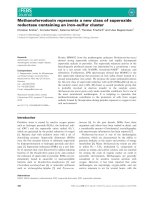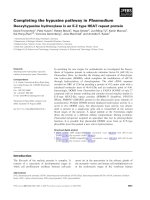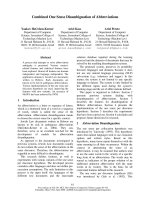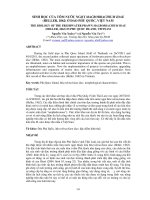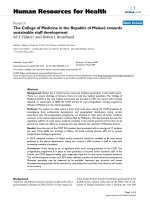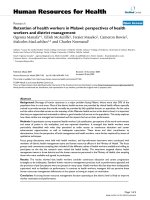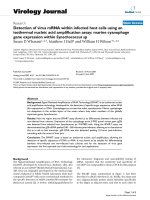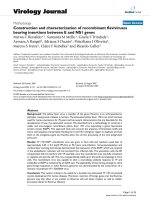Báo cáo sinh học: "Sometimes one just isn’t enough: do vertebrates contain an H2A.Z hyper-variant" docx
Bạn đang xem bản rút gọn của tài liệu. Xem và tải ngay bản đầy đủ của tài liệu tại đây (184.87 KB, 3 trang )
All species have to perform a balancing act with their
genome: cram it into the cell (in the case of eukaryotes, a
small part of that cell: for example, about 2 m of human
DNA in a nucleus of about 5 μm diameter) yet make the
appropriate regions readily available for replication and
expression (and repair if something goes wrong).
Eukaryotes achieve this feat by wrapping their DNA into
chromatin, a highly ordered complex with a simple
repeat ing unit of about 146 bp DNA plus eight histone
proteins, termed the nucleosome. is beads-on-a-string
array is further assembled into a variety of higher-order
structures all the way up to the metaphase chromosome.
e chromatin fi eld exploded with the discovery that the
monotonous-looking nucleosomes are actually hugely
variable, with post-translational modifi cations of numer-
ous residues on the major histones, their substitution for
histone variants, and even post-translational
modifi cations of the variants. Furthermore, the highly
regulated use of these marks serves to distinguish regions
of DNA (such as promoters, centromeres or damaged
DNA) to the appropriate enzymatic machineries.
Histone variants are non-allelic isoforms of the
canonical histones that can be assembled into nucleo-
somes in their place, and are thought thereby to provide
the basis for regulation of biological processes that
require local access to DNA. In contrast to the S-phase-
coupled synthesis of the major histones (timing avail-
ability to the peak demand of genome replication),
variants are generally expressed throughout the cell cycle.
Histone H2A has one of the largest variant families, and
includes H2A.Z, a protein that is highly conserved across
eukaryotes but diff ers considerably from the major H2A
in each species (Figure 1) [1]. H2A.Z has been ascribed a
large number of roles, including most recently suppres-
sing antisense RNAs [2] and stabilizing the association of
condensin with mitotic chromosomes [3]. Although we
still have a poor understanding of how the variant
mediates any specifi c function, it is likely that diff erential
enrichment at specifi c locations and distinct post-trans-
lational modifi cations contribute. H2A.Z at the inactive
X chromosome of mammalian female cells is mono-
ubiquitinated [4], that in budding yeast (Saccharomyces
cerevisiae) is sumoylated [5], and in all tested species it is
subject to multiple amino-terminal acetylations (Figure1),
primarily by the Kat5 family of acetyltransferases [1,3].
Mutation of the S. cerevisiae sumoylation sites impairs
movement of DNA double-strand breaks to the nuclear
periphery [5], whereas an unacetylatable allele in fi ssion
yeast (Schizosaccharomyces pombe) recapitulates many of
the phenotypes of a complete deletion [3]. However, it is
still unknown whether the eff ect of any of these
modifi cations is direct (such as steric hindrance or charge
modulation infl uencing the formation of higher-order
structures) or indirect (such as generating sites for the
recruitment of regulatory proteins).
The impact of H2A.Z on individual nucleosomes
e major route for H2A.Z into chromatin is via Swr1,
the Snf2-family ATPase at the catalytic center of the SWR
Abstract
How much functional specialization can one
component histone confer on a single nucleosome?
The histone variant H2A.Z seems to be an extreme
example. Genome-wide distribution maps show
non-random (and evolutionarily conserved) patterns,
with localized enrichment or depletion giving a
tantalizing suggestion of function. Multiple post-
translational modi cations on the protein indicate
further regulation. An additional layer of complexity
has now been uncovered: the vertebrate form is
actually encoded by two non-allelic genes that di er
by expression pattern and three amino acids.
© 2010 BioMed Central Ltd
Sometimes one just isn’t enough: do vertebrates
contain an H2A.Z hyper-variant?
Monika Mehta
¤
, Hyun-Soo Kim
¤
and Michael-Christopher Keogh*
See research articles and />MINIREVIEW
¤
These authors contributed equally to this work.
*Correspondence:
Department of Cell Biology, Albert Einstein College of Medicine, New York, NY
10461, USA
Mehta et al. Journal of Biology 2010, 9:3
/>© 2010 BioMed Central Ltd
chromatin remodeling complex. is is certainly the case
in S. cerevisiae (Swr1), S. pombe (Swr1), humans (SRCAP),
Drosophila (Domino) and Arabidopsis (PIE1) [2,3,6-8].
e presence of H2A.Z in a nucleosome facilitates intra-
molecular folding to higher-order arrays, particularly 30
nm chromatin fi bers, although these resist the formation
of more highly condensed structures resulting from inter-
molecular association [6]. H2A.Z has also been reported
to have a subtle destabilizing eff ect on the nucleosome in
which it is incorporated, although this has been disputed.
e apparent contradictions in the data can however be
reconciled if the total histone composition of a nucleo-
some octamer is considered: variants seem to subtly alter
nucleosome stability, so the order of stability is H3/
H2A.Z = H3/H2A > H3.3/H2A > H3.3/H2A.Z [9]. Further-
more, although it was originally predicted that H2A.Z
was unlikely to form hybrid nucleosomes (Figure1), both
homotypic (containing two H2A.Z:H2B dimers) and
hetero typic (containing H2A:H2B and H2A.Z:H2B dimers)
forms have been observed, adding yet another level of
structural (and possibly functional) heterogeneity [6,10].
Genome distribution maps of H2A.Z are suggestive
of function
High density maps of H2A.Z across genomes as diverse
as S. cerevisiae [6], S. pombe [8], Arabidopsis thaliana [7]
and Caenorhabditis elegans [2] show the variant to be
widely but non-randomly distributed. In budding yeast
H2A.Z occupancy peaks in the single nucleosomes
directly fl anking (-1/+1) a nucleosome-free region over
promoters, a pattern apparently induced by the nucleo-
some-free region itself [6]. Fission yeast, in contrast,
shows enrichment in the +1 but not the -1 nucleosome
around the nucleosome-free region [8]. e reason for
(or outcome of) this diff erence is unknown, although in
each organism enrichment depends on the SWR complex
and is inversely correlated with transcriptional activity.
H2A.Z has been linked to both transcriptional activation
and repression at various genes, although consensus
seems to be building towards a role in marking and/or
poising promoters for expression. e presence of H2A.Z
might commit local chromatin to a state competent for
activation by other factors or, in higher eukaryotes, it
might protect the region from inactivating DNA
methylation [7]. Or it might be that the cell uses the
inherent instability of H2A.Z-containing nucleosomes to
regulate promoter accessibility.
H2A.Z is found in ‘hot’ nucleosomes at promoters
and euchromatin-heterochromatin boundaries
Studies on the dynamics of replication-independent
histone turnover in budding yeast suggest that H2A.Z-
contain ing nucleosomes have signifi cantly higher turn-
over rates [6]. is ‘hotness’ of the nucleosomes around
transcription start sites could aid promoter function by
making it easier to expose these DNA elements to the
Figure 1. A simpli ed view of H2A.Z structure and post-translational modi cations. Bars indicate the major regions of divergence between
H2A.Z proteins across species (green) and between H2A.Z and H2A (blue). The relative location of the nuclear localization signal (NLS) and regions
of S. cerevisiae (Sc) H2A.Z (called Htz1) that mediate contact with the Nap1 chaperone and the SWR-complex (SWR-C) ATPase complex are also
shown. All H2A.Z post-translational modi cations identi ed so far are on the relatively divergent amino and carboxyl termini, so it is unclear
whether each speci c modi cation is invariably used to regulate variant function across species. Addition of post-translational modi cations
generally depends on the SWR complex, indicating that each modi cation occurs after the variant is assembled into chromatin [3,5]. A major region
of di erence between H2A and H2A.Z is in the Loop 1 domain, which regulates interaction between the two H2A molecules in a nucleosome. This
has led to the suggestion that nucleosome core particles can only be homotypic, containing either H2A or H2A.Z. However, hybrid nucleosomes
containing H2A:H2B and H2A.Z:H2B dimers have been observed [6]. The sequence of human H2A.Z-1, including the three residues that di er in
H2A.Z-2, is also indicated.
Acetylation
SumoylationUbiquitination
H2A.Z-1
H2A.Z-2
Loop1
H2A/H2A self
interaction domain
RTTSHGRVGA
T
VGRIHRHLK
S
A
AGGKAGKDSGKAK
T
KAVSR
Loop2
Interaction with
nucleosomal DNA
Docking domain
Interaction
with H3/H4
ELDSLI
GDE
A
KATIAGGGVIPHIHKSLIGKKGQQKT
V
αN α1 α2 α3 αC
Sc Htz1
Major divergence from H2A
Histone fold
Specific binding to
SWR-C
H2A.Z vs H2A.Z
H2A.Z vs H2A
NLS / Nap1 binding site
Most divergence across H2A.Zs
KVKRIT PRHLQLAIRSQRA GLQFP
TAAVYSAAILEYLTAEVLELAGNASKDL
Mehta et al. Journal of Biology 2010, 9:3
/>Page 2 of 3
transcriptional machinery. Such rapid fl ux might also
abrogate the spread of a propagating domain (such as
that of the budding yeast Sir2 deacetylase complex),
which could explain how H2A.Z mediates a hetero-
chromatin-euchromatin boundary function in this
organism [6]. H2A.Z enrichment at the regions between
euchromatin and heterochromatin is a feature also found
in other organisms, despite the dramatic biochemical
diff erences between the heterochromatin of budding
yeast and that of many other species. In this manner the
mammalian variant is a component of pericentric
heterochromatin and fl anks sites occupied by the
insulator binding protein CTCF [6,11].
A vertebrate H2A.Z hyper-variant
As if the complexity described above wasn’t enough,
recent mass spectrometry analyses of chicken erythro-
cytes identifi ed two forms of H2A.Z that diff er by just
three amino acids: H2A.Z-1 (previously H2A.Z) and
H2A.Z-2 (previously H2A.F/Z or H2A.V) (Figure1) [11].
ese proteins are encoded by two non-allelic genes,
which phylogenetic analyses indicate are present in all
vertebrates and have a common origin early in chordate
evolution [12]. Both isoforms are incorporated into
chromatin, and both seem to be acetylated on the same
three lysine residues within the amino terminus (Lys4,
Lys7 and Lys11) to a similar degree (Figure1) [11].
Why would vertebrates need two copies of a protein
that diff er by just three amino acids, whereas inverte-
brates do just fi ne with just one? Mouse studies ostensibly
showing that H2A.Z is indispensable deleted only
H2A.Z-1, indicating non-redundancy: that is, H2A.Z-2
cannot compensate. At this stage, we can only speculate
about the relevance of each isoform. e three-amino-
acid diff erence is not expected to have any major
structural implication for nucleosomes [12]. e H2A.Z
isoforms could have a diff er en tial affi nity for various
chaperones and/or deposi tion machineries, which could
explain their subtly diff er ent chromatin occupancy
patterns [11]. Although this might sound unlikely, there
is a comparable precedent: three of the four amino acids
that diff er between histones H3.1 and H3.3 regulate the
usage of the respective proteins in the replication-
dependent and -independent deposition pathways [13].
However, the most important diff erence between
H2A.Z-1 and H2A.Z-2 may be their highly divergent
promoter sequences [11]. is opens up the possibility of
dramatically diff erent temporal and/or spatial expression
patterns for the two isoforms. Indeed, preliminary studies
suggest some diff erences in mRNA expression levels
depending on the developmental stage of a variety of
tissues [11].
Plants also have multiple H2A.Z isoforms. ree have
been reported in A. thaliana - HTA8, HTA9 and HTA11 -
which share about 90% identity but have distinct
expression patterns, with HTA9 alone being cell-cycle-
independent [7]. PIE1 (the plant homolog of Swr1)
interacts with all three variants, but not with H2A. Single
knockouts have no distinct phenotypes, but double hta9/
hta11 knockouts show developmental abnormalities. It
remains to be seen whether these variants of the variant
have any tissue or developmental function [7]. However,
the parallel with vertebrates is striking and may suggest
that more complex organisms need more fi nely tuned
chromatin than one H2A.Z can provide.
Published: 21 January 2010
References
1. Thambirajah AA, Ishibashi T, Ausio J: New developments in post-
translational modifi cations and functions of histone H2A variants. Biochem
Cell Biol 2009, 87:7-17.
2. Zofall M, Fischer T, Zhang K, Zhou M, Cui B, Veenstra TD, Grewal SI: Histone
H2A.Z cooperates with RNAi and heterochromatin factors to suppress
antisense RNAs. Nature 2009, 461:419-422.
3. Kim HS, Vanoosthuyse V, Fillingham J, Roguev A, Watt S, Kislinger T, Treyer A,
Carpenter LR, Bennett CS, Emili A, Greenblatt JF, Hardwick KG, Krogan NJ,
Bähler J, Keogh MC: An acetylated form of histone H2A.Z regulates
chromosome architecture in Schizosaccharomyces pombe. Nat Struct Mol
Biol 2009, 16:1286-1293.
4. Sarcinella E, Zuzarte PC, Lau PN, Draker R, Cheung P: Monoubiquitylation of
H2A.Z distinguishes its association with euchromatin or facultative
heterochromatin. Mol Cell Biol 2007, 27:6457-6486.
5. Kalocsay M, Hiller NJ, Jentsch S: Chromosome wide Rad51 spreading and
SUMO-H2A.Z-dependent chromosome fi xation in response to a persistent
DNA double-strand break. Mol Cell 2009, 33:335-343.
6. Zlatanova J, Thakar A: H2A.Z: view from the top. Structure 2008, 16:166-179.
7. March-Díaz R, Reyes JC: The beauty of being a variant: H2A.Z and the SWR1
complex in plants. Mol Plant 2009, 2:565-577.
8. Buchanan L, Durand-Dubief M, Roguev A, Sakalar C, Wilhelm B, Strålfors A,
Shevchenko A, Aasland R, Shevchenko A, Ekwall K, Francis Stewart A: The
Schizosaccharomyces pombe JmjC-protein, Msc1, prevents H2A.Z
localization in centromeric and subtelomeric chromatin domains. PLoS
Genetics 2009, 5:e1000726.
9. Jin C, Felsenfeld G: Nucleosome stability mediated by histone variants H3.3
and H2A.Z. Genes Dev 2007, 21:1519-1529.
10. Ishibashi T, Dryhurst D, Rose KL, Shabanowitz J, Hunt DF, Ausió J: Acetylation
of vertebrate H2A.Z and its eff ect on the structure of the nucleosome.
Biochemistry 2009, 48:5007-5017.
11. Dryhurst D, Ishibashi T, Rose KL, Eirín-López JM, McDonald D, Silva-Moreno B,
Veldhoen N, Helbing C, C, Hendzel MJ, Shabanowitz J, Hunt DF, Ausio J:
Characterization of the histone H2A.Z-1 and H2A.Z-2 isoforms in
vertebrates. BMC Biol 2009, 7:86.
12. Eirín-López JM, González-Romero R, Dryhurst D, Ishibashi T, Ausió J: The
evolutionary diff erentiation of two histone H2A.Z variants in chordates
(H2A.Z-1 and H2A.Z-2) is mediated by a stepwise mutation process that
aff ects three amino acid residues. BMC Evol Biol 2009, 9:31.
13. Ahmad K, Heniko S: The histone variant H3.3 marks active chromatin by
replication-independent nucleosome assembly. Mol Cell 2002, 9:1191-1200.
Mehta et al. Journal of Biology 2010, 9:3
/>doi:10.1186/jbiol214
Cite this article as: Mehta M, et al.: Sometimes one just isn’t enough: do
vertebrates contain an H2A.Z hyper-variant? Journal of Biology 2010, 9:3.
Page 3 of 3
